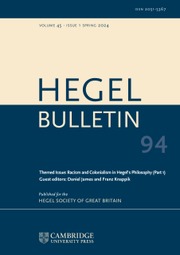No CrossRef data available.
Article contents
Angelica Nuzzo, Approaching Hegel's Logic, Obliquely: Melville, Molière, Beckett. Albany: State University of New York Press, 2018. ISBN 9-781-438-47205-8 (hbk). ISBN 9-781-438-47204-1 (pbk). Pp. 454. $37.95.
Review products
Angelica Nuzzo, Approaching Hegel's Logic, Obliquely: Melville, Molière, Beckett. Albany: State University of New York Press, 2018. ISBN 9-781-438-47205-8 (hbk). ISBN 9-781-438-47204-1 (pbk). Pp. 454. $37.95.
Published online by Cambridge University Press: 09 May 2024
Abstract
An abstract is not available for this content so a preview has been provided. Please use the Get access link above for information on how to access this content.
Information
- Type
- Book Review
- Information
- Copyright
- © The Author(s), 2024. Published by Cambridge University Press on behalf of The Hegel Society of Great Britain


